Key takeaways:
- Framing directs the viewer’s eye and shapes the emotional narrative of a photograph, emphasizing its importance in storytelling.
- Different perspectives can dramatically alter the perception of a scene, creating intimacy or grandeur depending on the angle chosen.
- Effective framing techniques, such as using natural elements and applying the rule of thirds, enhance depth and engagement in images.
- Exploring negative space and close-up framing can evoke strong emotions and create unique connections with the subject.
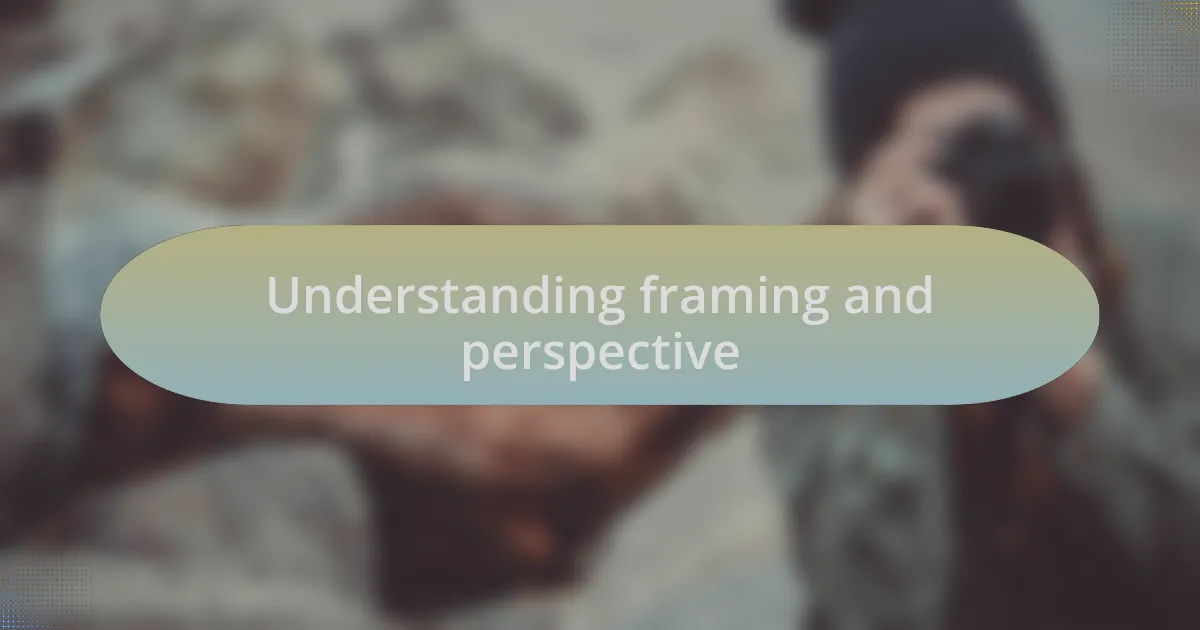
Understanding framing and perspective
Framing and perspective are the backbone of any compelling photograph. I remember the first time I captured a sunset, using the trees in the foreground to frame the vibrant colors. That moment taught me how framing can direct the viewer’s eye and create a sense of depth—did you ever think about how simple elements can transform an image?
As I delve deeper into my photography journey, I’ve noticed that perspective isn’t just about angle; it’s about emotional storytelling. I once shot a portrait from below eye level, and the subject appeared both powerful and vulnerable. This experience made me question: how can our choice of perspective influence the feelings a photograph evokes?
What often surprises me is how a small shift in framing can change the narrative of a picture entirely. I’ve experimented with leading lines and negative space, finding that the context surrounding the subject can either enhance or detract from its importance. Have you ever considered how your own framing choices impact the story you convey through your lens?
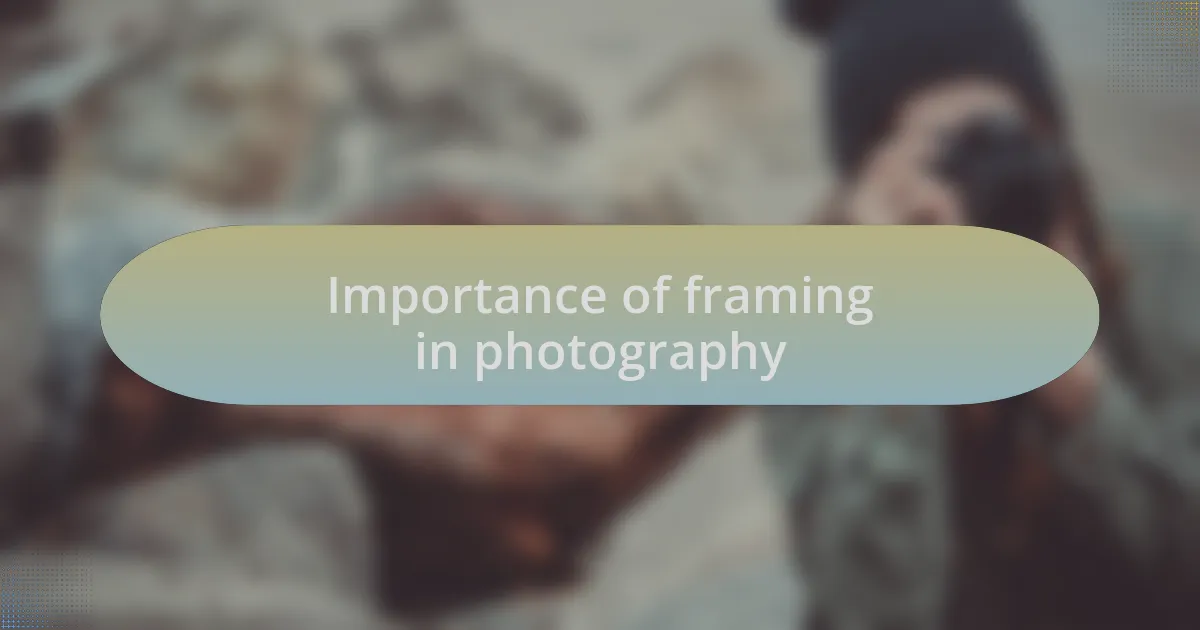
Importance of framing in photography
In my experience, framing is crucial because it helps establish focal points within an image. I vividly recall a time when I zoomed in on an old man holding a walking stick, and the way I framed the shot surrounded him with blurred colors of the market. It drew the viewer’s attention straight to his weathered face, imbuing the image with life stories that words can’t express. Have you ever noticed how your eyes are immediately drawn to certain elements in a well-framed photograph?
A well-chosen frame can also evoke emotions and set a mood. One early morning, as mist crept over a lake, I positioned my camera so that the reflections in the water and the trees encapsulated the scene. The composition created a tranquil atmosphere, almost like stepping into a dream. Does framing not serve as a beautiful way to translate feelings to the viewer?
Moreover, the importance of framing extends to storytelling within photography. I once took a series of images in a bustling city, isolating a single passerby through a window frame. This technique transformed a chaotic setting into a narrative of solitude and introspection. Have you thought about how your framing can speak volumes about the context of your subject?
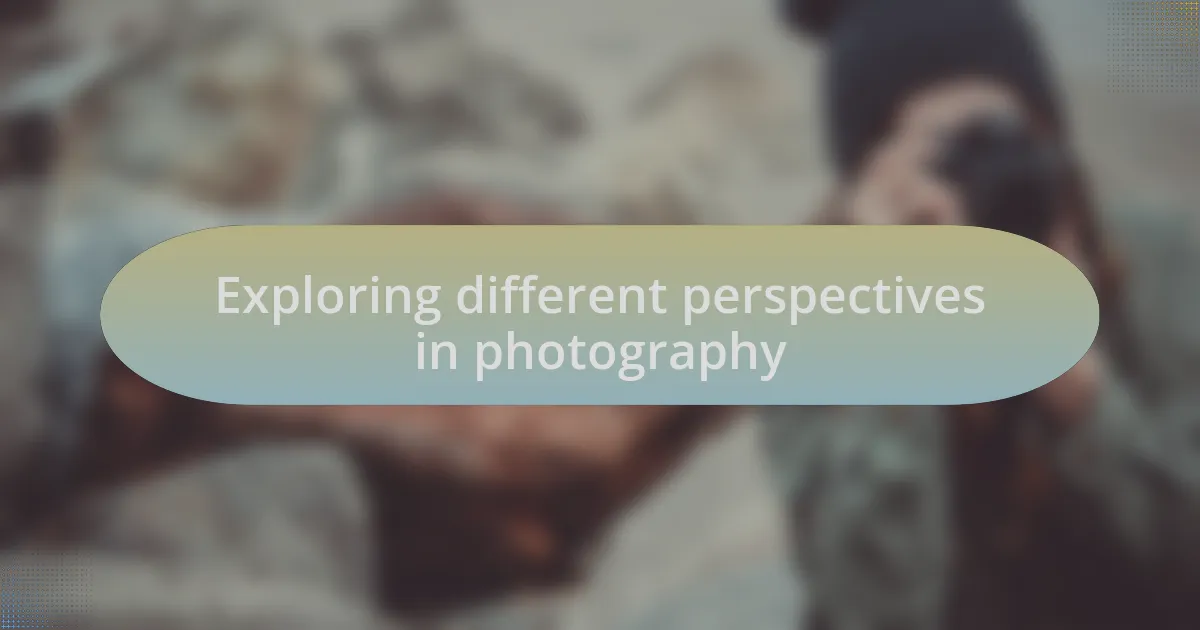
Exploring different perspectives in photography
Exploring different perspectives in photography can completely change how a scene is perceived. I remember an afternoon spent shooting in a busy cafe, where I chose to capture my subjects from below their eye level. This unique angle not only highlighted their expressions but also added a layer of intimacy, making the viewer feel like they were part of a private conversation. Have you ever tried changing your viewpoint to see your subject in a whole new light?
The beauty of varied perspectives lies in their ability to convey distinct moods. For instance, during a sunset shoot on a remote beach, I decided to position my camera so that it faced towards the shore, capturing the waves crashing against sand. The resulting image had an epic quality, making the viewer feel small in the presence of nature’s grandeur. Doesn’t that perspective evoke a sense of awe that a standard eye-level shot simply can’t?
Additionally, experimenting with unconventional viewpoints can often lead to unexpected results. While photographing street art, I once crouched low to the ground to capture the details of a mural from a worm’s-eye view. This strategy transformed the artwork into something powerful, pulling the viewer into the scene and making them aware of the environment surrounding the piece. Have you noticed how switching up your angle can turn an ordinary shot into a remarkable story?
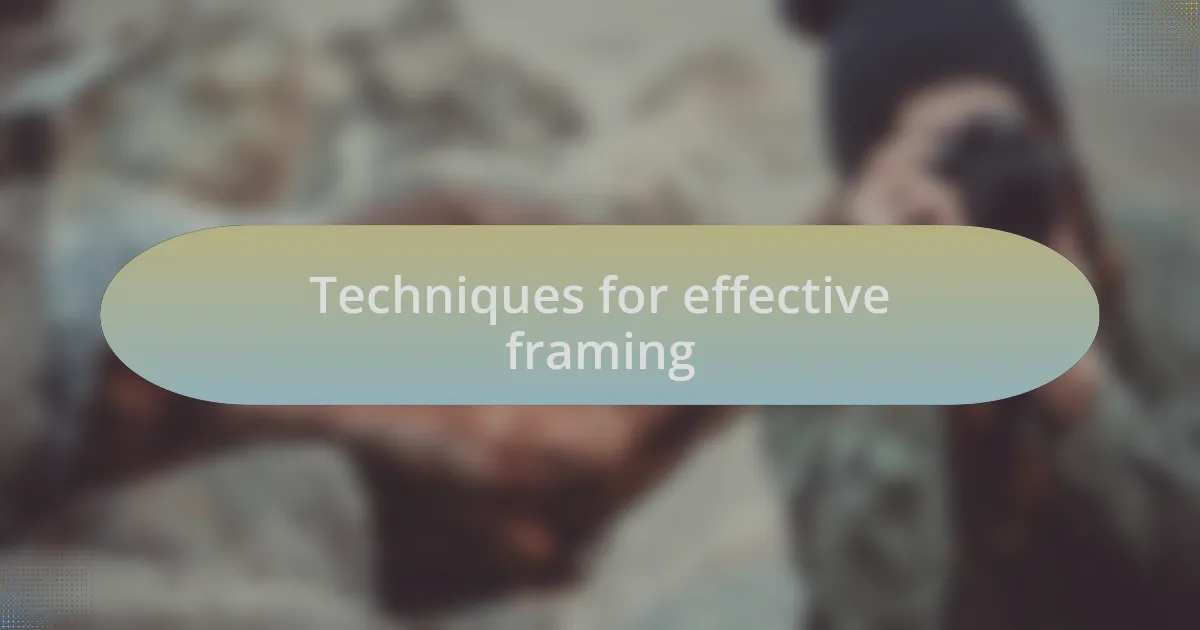
Techniques for effective framing
When it comes to effective framing, one technique I find particularly valuable is using natural elements as foreground objects. On a hike last autumn, I stumbled upon a vibrant cluster of leaves. By placing them in the foreground while capturing the mountain scenery behind, I created depth in my image. This added a rich layer of context; have you ever tried incorporating elements from your surroundings to enhance your photos?
Another fabulous technique is the rule of thirds. While shooting a sunrise recently, I applied this principle by positioning the horizon along the top third of the frame. This relatively simple adjustment made the image more dynamic, guiding the viewer’s eye through the photo while highlighting the stunning colors of the sky. Isn’t it fascinating how a slight shift in alignment can transform an otherwise flat scene into something more engaging?
I also love to experiment with symmetry and leading lines. One afternoon at a local park, I discovered a pathway lined with trees. By framing my shot to create a tunnel effect, I drew the viewer’s eyes straight to a couple walking hand in hand. That moment resonated with warmth and connection, proving how framing can tell a story. Have you ever considered how your choice of lines and shapes within a frame can direct emotions in your photography?
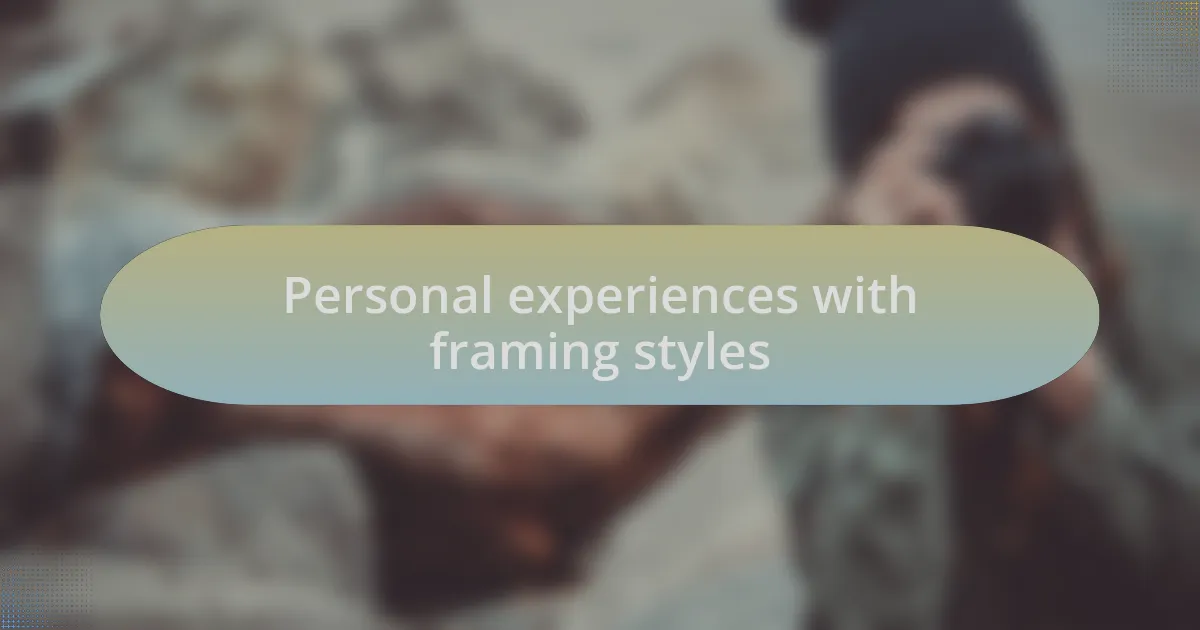
Personal experiences with framing styles
When I first experimented with framing styles, the impact of negative space really struck me. On a foggy morning by the coast, I captured a solitary rock sitting amidst an expansive beach. The vast emptiness around the rock evoked a sense of isolation and contemplation, leading me to wonder how much power silence holds in photography. Have you ever considered how the absence of elements can convey such strong emotions?
Another memorable experience was when I decided to focus on close-up framing during a vibrant flower festival. I was drawn to the intricate details of a single bloom. By filling the frame with its delicate petals and vibrant colors, I aimed to evoke an intimate connection with the viewer. This approach made me realize how close-ups can create a unique relationship between the subject and the observer. Have you explored capturing the beauty in smaller details?
One of my more adventurous outings involved using unconventional framing techniques. I ventured into an urban environment and found myself photographing reflections in puddles after a rainstorm. In one shot, I framed the buildings above with their mirrored looks on the wet surface, leading to a captivating duality. This experience taught me that creativity in framing styles can unlock entirely new perspectives. What strategies do you use to push the boundaries of your photography?
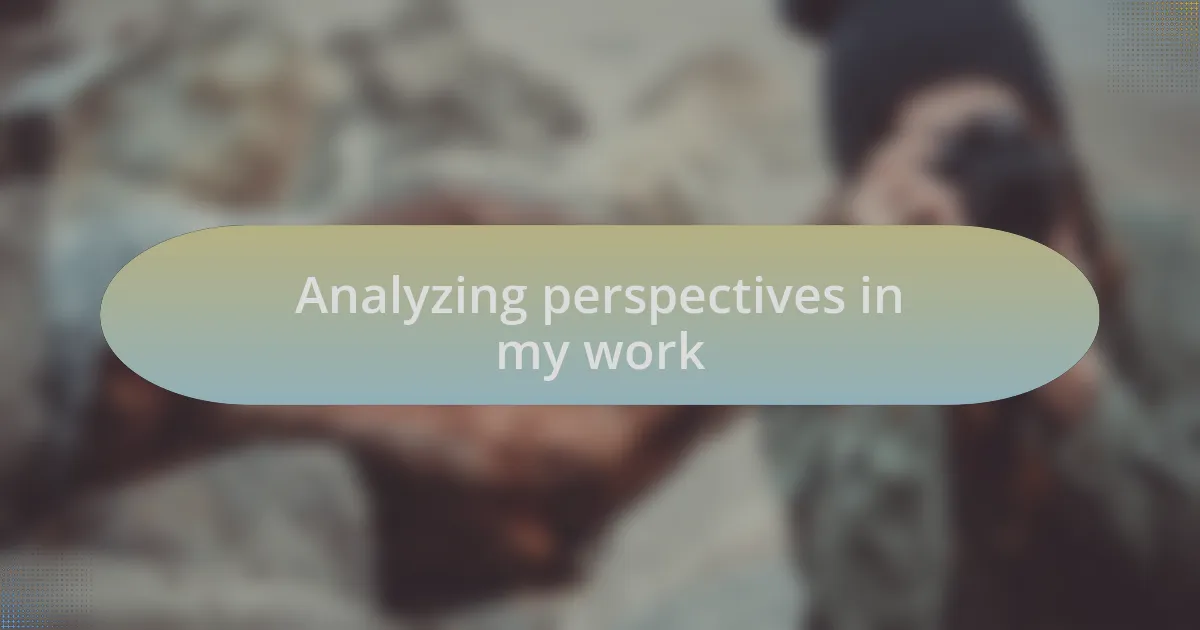
Analyzing perspectives in my work
When I delve into the perspectives in my work, I often reflect on a trip to the mountains, where I played with depth and layering in my compositions. I positioned a foreground element—an ancient tree—against the sweeping backdrop of peaks. This not only created a sense of scale but also infused the scene with a feeling of timelessness. Have you ever noticed how including layers can transform an image from flat to three-dimensional?
Another significant moment for me was during a candid street photography session while traveling through a bustling market. I aimed to capture a busy intersection, focusing on the expressions of people as they navigated their day. By including elements of motion and emotion, I found myself drawing viewers into the story behind those fleeting moments. Isn’t it fascinating how the right perspective can turn a mundane scene into a narrative masterpiece?
I also remember a time spent at a local art gallery, where I found inspiration in the work of others. I experimented with framing my subjects in unconventional angles that challenged traditional viewpoints. One specific shot featured a sculpture, framed dramatically from below to emphasize its imposing stature against the gallery ceiling. This perspective shift not only made the sculpture more powerful, but it also sparked a deep conversation about how angles can alter perception. Have you ever thought about how a simple tilt of the camera can breathe new life into a subject?